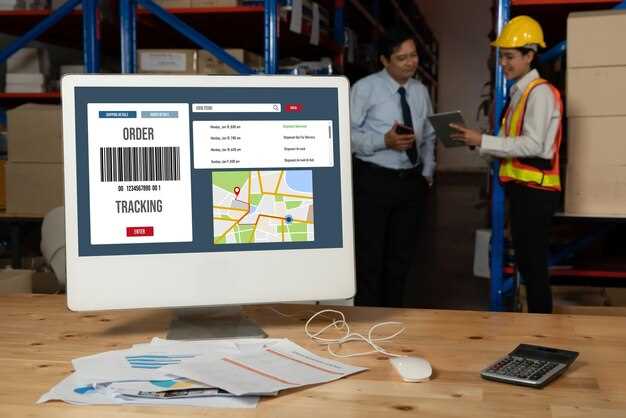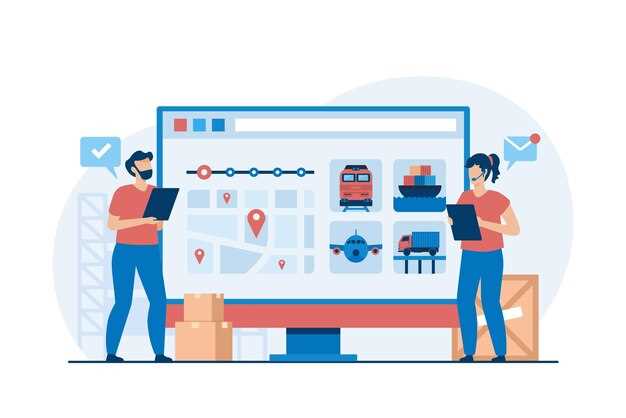Choosing real-time routing with traffic-aware dispatch will immediately reduce miles and idle time, boosting productivity. In a case with a 150-vehicle fleet, this approach minimizes idle time by 15–20% and cuts miles by 12–18% in the first three months; after that, benefits compound as routes stabilize. That would take a controlled pilot on a subset of routes, then expand across the network into the broader program to confirm the gains already recorded in similar operations.
End-to-end visibility built on recorded events, GPS traces, and live ETA updates lets you meet windows and reduces inquiries. In case studies, brands report a 20–30% drop in missed ETAs and a 25–40% decrease in status inquiries after adopting this layer. When choosing among systems, look for API access, event-level data, and a portable feed that can be integrated into dashboards; theyre ready to inform daily decisions and, also, to guide the brand and its fleet.
Streamlined driver communications and handoff confirmations keep operations aligned. In-vehicle prompts, automated alerts, and in-app messaging reduce misroutes; theyre able to acknowledge handoffs in real time, and all confirmations are recorded for the brand’s audit trail. This clarity minimizes dispatch errors and improves final-mile execution.
Analytics and benchmarking turn data into actionable steps. A concise guide to choosing a platform should include metrics for final cost per stop, traffic-adjusted time, and productivity per driver. With ready dashboards and available benchmarks, teams can meet targets faster, see the benefits in weeks rather than quarters, and turn insights into everyday improvements. Already, many brands have seen cost per stop fall 8–15% after three months; further, you can extend gains by standardizing handoffs and regional routing.
Ultimate Guide to Last-Mile Delivery Management Software

Start with a centralized system that directly connects with brands and carriers, enabling real-time routing, status updates, and automated hand-offs.
Focus on three core capabilities: integration with the supply network, dynamic routing, and end-to-end visibility. These drive measurable improvements in on-time performance and satisfaction.
Through utilization of live data, minimize non-delivery events by optimizing carrier mix, modes, and cargo assignments. Align main objectives with demand patterns to balance workloads before peak periods.
Prioritize drivers and touchpoints: equip mobile apps for status updates, proof of pickup, and cargo scans. This reduces friction and improves satisfaction across partners, especially for brands that operate long-haul routes and multiple vehicles.
Adopt a staged approach: start with essential integrations, then expand to full routing and logistics dashboards. This ensures the rise in efficiency is steady and the risk of disruption is low.
Test each feature against real-world scenarios: on-time, non-delivery, and delivered-confirmation workflows to validate value.
Before selecting a solution, compare integration breadth: ensure support for order orchestration, shipping labels, and non-delivery risk modules. A system that provides delivered status updates, proactive alerts, and proactive exception handling helps minimize non-delivery and boosts customer satisfaction. Already used by several top brands, this approach makes operations more resilient and fully scalable, especially when demand spikes.
| Aspect | Practice | Hatás |
|---|---|---|
| Carrier integration | APIs with main carriers, including long-haul fleets and regional brands | reduces manual touch by 40-50% |
| Routing optimization | dynamic algorithms that consider demand, routes, cargo, and modes | boosts on-time share by 15-20% |
| Visibility & alerts | live tracking, non-delivery alerts, and delivered confirmations | improves customer satisfaction by 10-25% |
| Driver app | offline maps, touchless scans, status updates to customers and ops | reduces dwell time and speeds hand-offs |
Define Destination Types: Residential, Commercial, Locker, and Pickup Points

Classify destinations into four types–Residential, Commercial, Locker, and Pickup Points–and encode this taxonomy into routing rules to increase accuracy and reduce trips.
Residential: verified addresses, gate codes, and preferred contact; Commercial: dock width, access doors, pickup windows; Locker: locker ID, release code, and pickup window; Pickup Point: store hours, location ID, and pickup verification.
This categorization shapes routing decisions, improves dock utilization, and minimize manual touch by drivers. The impacts include shorter trips, fewer exceptions, and a lower rate of wrong-handovers.
Below are practical steps to implement, using integration with providers and addressing data quality: map customer addresses to the four types, enrich with fields per type, set up rules that push locker or pickup points to collect in specific windows, and notify drivers accordingly.
Once configured, run a demo to validate assumptions; compare shipping times and report on key metrics such as on-time share, average handover time, and failed handovers. The reason for improvements becomes clear after reviewing the data, and done with the validation, thats the moment to scale.
Integration with courier providers and store networks adds coverage and speeds up onboarding; this approach works with three product families: lockers, stores, and home addresses. These products cover lockers, pickup storefronts, and residential routes. A case demonstrates how a retailer reduced handover attempts by 25% after adopting destination-type routing.
After deployment, track below KPIs: increase in pickup rates at lockers, decrease in failed drop-offs, and a unified report that shows which routes, spots, and providers drive results. That data helps you find optimization opportunities and tailor plans for different regions.
Ultimately, a well-defined destination map reduces problems, lowers manual interventions, and keeps people satisfied while keeping products moving through lanes with minimal waits.
Destination-Type Aware Routing: Apply Rules and Constraints by Destination
Configure rules by destination category and let the routing engine adjust automatically to real-time conditions. This ensures each route meets constraints that match the recipient, whether a store, campus, or residential cluster. Start with a demo in a small group of stores, then, once results are verified, push adoption across the network.
Define destination types such as stores, campuses, residential neighborhoods, and remote depots. For each category, set time windows, access rules, vehicle type, and staging points. Each constraint influences the route decision and helps prevent problems at the point of handoff, addressing needs of managers and customers alike.
Cost control comes from selecting the great-fit fleet for each task and avoiding trips that cause long idle times. By splitting destinations, you can lift cargo visibility, shorten distance, and allow more stops within shift room, reducing the amount of fuel burned. This is especially valuable for last-mile tasks.
Measure success with number-based dashboards: number of non-delivery events, on-time points, and cargo incidents by destination type. A solid rule set should improve route efficiency. Managers can adjust constraints after patterns emerge, and adoption grows as teams see tangible results. This isnt a one-off tweak, it requires ongoing calibration.
For consumers, the impact is tangible: fewer problems, tighter handoff windows, and clearer status updates theyre confident in. Stores report higher throughput, while the fleet gains predictable workloads. After rollout, run a post-demo review to capture lessons learned and refine rules for the network.
Implementation steps: build a destination-type library with attributes, feed accurate demand signals, and maintain room in the route library for exceptions. This sandbox demo allows rapid learning, monitor cost and service level, and ensure the approach scales as demand rises. The result is a repeatable process that improves adoption among managers who want more control over each shipment.
Real-Time Tracking and ETA with Time Windows for Each Destination
Begin with a live-tracking layer that shows vehicle position, ETA, and a time window for each destination. This includes per-stop targets that absorb snarls and vary with traffic, weather, and load. Set default windows for urban routes at 10-15 minutes and 15-25 minutes for longer legs, then adjust based on observed performance.
todays operations require well-informed signals; the platform should show ETA shifts as conditions change and carry a clear history of deviations. The system ensures a likely arrival range for each stop, so planners can find and keep customers and dispatchers informed. This approach gives dispatchers a look at performance trends and provides them with concrete signals to act on.
Dynamic routing and time windows are pillars of an efficient operation; they are the main anchors that set expectations and prevent brittle schedules. These windows should be dynamic and adjustable based on real-time feeds from traffic, weather, and driver pace, with each destination assigned a suitable window that balances reliability and carrier availability.
Historical data shows that aligning windows with actual routes raises on-time share, and yields a reliable ETA band within a tight margin. Start with a baseline of 15 days of corridor data and test windows of 5, 10, or 15 minutes depending on distance and curb rules. In urban markets, aim for 85-92 percent of arrivals within the chosen window, and use wider slots for peak periods to protect overall reliability.
Electric fleets and bicycle-based operations are very suitable for dense urban zones, where e-commerce flows often demand near-doorstep time. Time windows help ensure carriers can carry shipments without excessive idle time while keeping end customers satisfied. While these options are available, maintain charging schedules, bike checks, and routine vehicle health checks to avoid delays during high-pressure periods.
Implementation steps start with defining time-window templates, then integrate telematics and a mapping engine that feeds live ETAs. Run a pilot in a single district to find practical defaults, then scale. Main tasks include setting per-stop windows, enabling automatic re-dispatch if ETA drifts beyond window, and notifying customers with accurate status updates. These measures ensure high adherence and reduce manual interventions.
The payoff is measurable: higher on-time rates, lower customer inquiries, and less pressure on drivers. Available dashboards reveal per-route performance, highlight snarls, and guide continuous improvement. Attention to per-destination windows would raise service quality and lower risk during peak periods.
Delivery Proof, Exceptions, and Compliance by Destination Type
Implement a destination-type aware proof flow: touch-confirmation at handoff and automatic recording of evidence, then route to an accessible dashboard for every destination type. This approach improves accuracy, reduces room for interpretation, and saves time on audits.
- Urban destinations
Urban routes demand a multi-point touch record: a door photo, a time stamp, and GPS coordinates captured automatically at the moment of handoff. Include a quick, optional recipient confirmation to ensure the right interaction. Evidence is recorded and stored in the dashboard so that the experience is consistent across shifts. In practice, this reduces problems by a measurable margin and speeds up the turnover window, with reports showing faster close times and fewer disputes for dense corridors.
- Suburban corridors
Proof should support curbside or lobby handoffs, with a photo, timestamp, and access method note (concierge, intercom, or code). Automatic synchronization keeps data accurate and accessible, and the system should flag any mismatch instantly. This setup saves travel time, improves first-attempt success, and yields higher completion rates on the same day.
- Rural and remote locations
Offline-capable capture is essential: capture touch, timestamp, and location when connectivity is weak, then automatically synchronize when a signal is available. Recorded evidence becomes part of the fleet-wide dashboard, enabling faster recoveries if a drop is not completed. Special handling may be needed for weather-related delays, but the core proof remains consistent and traceable.
- Residential multi-tenant buildings
Use a combination of photos, door-knock notes, and access-checks (intercom, building code, or concierge). Ensure proof is recorded automatically and linked to the specific unit, which improves accountability and reduces room for misdelivery. The approach supports room-by-room clarity and a smoother experience for recipients.
Exceptions and escalation by destination type
- Common reasons
No-access, address mismatch, recipient unavailable, safety hold, or courier safety stop. Each event should receive a clear, coded note along with the accompanying proof (photo, timestamp, and location data) and be reflected in the dashboard for visibility by the fleet supervisor.
- Handling and retries
When an exception occurs, generate an automatic retry window and notify the appropriate driver pair. Log the reason, attach the evidence, and propose alternative drop points or time windows. This practice avoids repeated trips and improves overall efficiency.
- Compliance checks
Review every exception against destination rules (privacy, access controls, and recording standards). Ensure that face blur and data minimization are applied where needed and that retention periods align with policy. The report should cover each case and highlight factors that led to resolution or recurrence.
Compliance by destination type: data and governance
- Urban
Centralized reporting includes accuracy checks, touch proof coverage, and evidence trails for every drop. Maintain short retention windows to support sustainability goals and minimize clutter in the dashboard.
- Suburban
Proof packets should be searchable by address, unit, and access method. Accessibility considerations (door width, ramp access, and timing constraints) should be documented in each case, improving the overall experience for residents and property managers alike.
- Rural and remote
Store offline proofs securely with automatic sync when online. Include notes about connectivity limitations and weather-related factors to explain any gaps. This approach keeps the dataset complete and useful for audits and sustainability reporting.
- Residential complexes
Attach unit-level identifiers and concierge records to each event. Ensure that data access is restricted to authorized roles and that handling aligns with privacy requirements. The system should deliver transparent, auditable reports that support continuous improvement across the fleet.
Overall, the proposed approach keeps evidence accurate, makes exceptions actionable, and ensures that every handoff is touch-confirmed and recorded once. It builds a faster, more responsible flow that would satisfy stakeholders, supports sustainability goals, and provides clear, data-driven insights in each report.

 4 Key Features Every Last-Mile Delivery Management Software Must Have">
4 Key Features Every Last-Mile Delivery Management Software Must Have">
